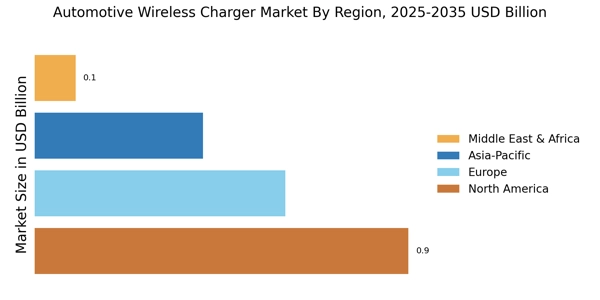Growth of Electric Vehicles
The Automotive Wireless Charger Market is closely linked to the growth of electric vehicles (EVs). As the adoption of EVs continues to rise, the demand for compatible charging solutions, including wireless chargers, is expected to increase correspondingly. Data indicates that the EV market has seen a compound annual growth rate of over 20% in recent years. This growth presents a significant opportunity for the wireless charging sector, as manufacturers seek to provide integrated solutions that enhance the user experience for EV owners. The synergy between EV growth and wireless charging technology is likely to drive innovation and investment in the Automotive Wireless Charger Market.
Rising Demand for Convenience
The Automotive Wireless Charger Market is experiencing a notable increase in demand for convenience features in vehicles. As consumers seek seamless integration of technology into their daily lives, the ability to charge devices wirelessly while driving has become a desirable attribute. This trend is supported by data indicating that approximately 60% of consumers prioritize convenience in their vehicle features. Consequently, automotive manufacturers are increasingly incorporating wireless charging solutions into their designs, enhancing the appeal of their vehicles. This shift not only caters to consumer preferences but also positions manufacturers competitively in a market that values innovation and user-friendly technology.
Consumer Awareness and Education
Consumer awareness regarding the benefits of wireless charging is gradually increasing, positively impacting the Automotive Wireless Charger Market. As more consumers become educated about the convenience and efficiency of wireless charging solutions, their willingness to invest in vehicles equipped with such technology is likely to rise. Surveys indicate that nearly 70% of consumers are open to considering vehicles with wireless charging capabilities, provided they understand the advantages. This growing awareness is prompting manufacturers to highlight wireless charging features in their marketing strategies, thereby fostering a more informed consumer base and driving market growth.
Advancements in Charging Technology
Technological advancements play a pivotal role in the Automotive Wireless Charger Market. Innovations in charging efficiency and speed have led to the development of more effective wireless charging systems. Recent data suggests that the efficiency of wireless charging systems has improved significantly, with some systems achieving up to 90% efficiency. This enhancement not only reduces charging times but also addresses consumer concerns regarding battery life and performance. As manufacturers adopt these advanced technologies, the market is likely to witness increased adoption rates, as consumers become more aware of the benefits associated with modern wireless charging solutions.
Regulatory Support for Innovative Technologies
Regulatory frameworks are increasingly supporting the integration of innovative technologies in the Automotive Wireless Charger Market. Governments are recognizing the importance of promoting advanced charging solutions to enhance energy efficiency and reduce carbon emissions. Policies encouraging the adoption of wireless charging technologies are being implemented, which may lead to increased investment in research and development. This regulatory support not only facilitates the growth of the wireless charging market but also aligns with broader sustainability goals. As regulations evolve, manufacturers are likely to respond by developing more advanced and compliant wireless charging systems, further propelling the market forward.


















Leave a Comment